‘Yeah, all right,’ I said, to a cheeky young lad,
The lad was standing outside Cartwright Hall.
Which is in Lister Park.
Which is on the edge of Manningham, in Bradford, West Yorkshire.
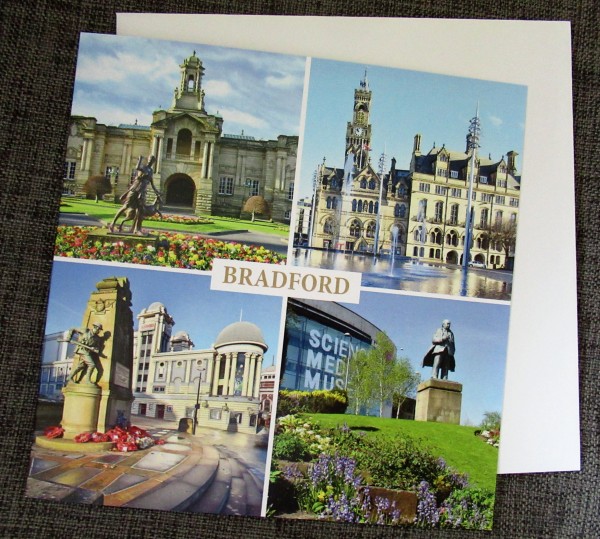
Cartwright Hall, City Hall, War memorial & Alhambra theatre, National Media Museum. Card by http://www.landscapeandlightphotography.com
I’d been avoiding real world issues for a while, but knew I couldn’t hold out forever. And that ‘yeah, all right,’ or, more accurately, the place, the boys, the context, were a turning point.
Bear with me while I tell you a little about that context. It will make my post longer than usual, but it’s necessary, for it to make sense.
Bradford, with an estimated 534,300 inhabitants is the fifth largest Metropolitan District in England by population, after Birmingham, Leeds, Sheffield and Manchester.
That may come as a surprise to a lot of people (it did to me). We don’t hear about Bradford often. And usually only when there’s a problem.
Of Bradford’s population, 63.9% identifies as ‘White British.’
It has the largest proportion of people of Pakistani ethnic origin -20.3% – in England.
Manningham ward adjoins what was once an affluent, desirable residential area, Heaton.
White* people constitute 14.9% of Manningham’s population.
Pakistanis account for 60.3%.
A further 16.8% of people identifying as Asian* comprise Indians, 4.5%; Bangladeshis, 9%; ‘Other Asian,’ 3.3%.
By religion, the two largest faiths are Muslim at 75%; 12.7% Christian.
Manningham is one of 12 wards in Bradford District which are amongst the 10% most deprived wards in England. It is the most deprived ward in terms of income and employment.
In 2013-2015 life expectancy at birth for both males and females was lower than the District average. Males had the lowest life expectancy rate in the District.
17.8% of households in Manningham live in overcrowded homes, the highest rate in the District.
[All above statistics from City of Bradford Metropolitan District Council ‘Understanding Bradford’ Intelligence Briefing November 2017]
Lister’s Mill – completed in 1873, sometimes known as Manningham Mills – was once the largest silk mill in the world, famed for its velvet. In 1976 it supplied new curtains for President Ford’s White House.
At one stage it employed 11,000 men, women and children. A strike in 1890-1891 led to the formation of the Independent Labour Party which later helped create the Labour Party.
Bradford’s textiles, its woollen industry, once led the world. This is why so many immigrants from Asia but also Poland, Ukraine and Czechoslovakia (as was) came to live in Bradford. The jobs.
Lister’s Mill closed in 1992. The woollen industry that made Bradford rich had already withered and pretty much died. The city is littered with its vast stone carcases, studded like vacant eyes with broken glass windows.
Lister Park I’ve mentioned before, a place I roller-skated, played and nurtured a fascination for fossils on my frequent visit to Cartwright Hall.
The award-winning park is large, contains a boating lake, tennis courts, a botanic garden, Mughal water gardens, sculpture and more.
The image below is of a road off the back of the park, where seven-year-old-me spent a happy few months. My father had taken a job as head of a new school, which was yet to be built. We lived here briefly while my family sought a permanent home.

The elaborate chimney towering above the road is Lister’s Mill chimney, 249 feet/76 metres high. My teacher (who lived in this road) told me your could drive a coach and horses around that parapet – what an image!
I took the photograph from the edge of the park. Before I raised my camera, several men were dotted around the scene. As I pointed the lens they vanished, in a flurry of long white robes. Probably a coincidence.
Cartwright Hall
In the dying years of the 19th century, Samuel Lister offered Bradford Corporation £50,000 (around £1 million in today’s money) to demolish his old family home, Manningham Hall in Lister Park, and build a new art gallery and museum.
It was named for Rev Dr Edmund Cartwright (1743-1823), who invented the first power loom for woollen weaving but did not gain from it. All future power looms were developed from it, including those used and improved by Lister, who invented the ‘Lister nip comb,’ which allowed further mechanisation of the silk, Alpaca and mohair industry.
Completed in 1903, in a style some call ‘Bradford Baroque,’ it’s a classic example of industrial-era civic philanthropy.
Inside Cartwright Hall, things have changed a lot since I was small.
The fossil and stuffed creatures are gone. In the upper gallery, Asian art now mingles with pre-Raphaelites and grand-old-men in marble.
It would probably have shocked the original patrons to see not only the art in the new-ish Hockney Gallery, but its accommodation of the viewpoints of children.
It would definitely have shocked them to see the use to which Monty Python put Cartwright Hall in this song.
(Apologies if anyone is offended. Despite being brought up Catholic I find it a hoot)
But back to our visit.
We looked at art, we bought cards, we left the building.
Outside, though, I hung back, absorbing the massive scale of the stonework.
Then three boys irrupted into the scene.
‘Tek mi picture,’ yelled the sparkiest, in an Asian-Bradford accent.
‘Yeah,’ I said. ‘All right.’
One boy ran away, smirking.
The others posed. Such different boys, one evidently the leader.
’Well,’ I said, the moment now awkward, ‘want to see it?’
They shuffled over.
‘Looks as if it’s good,’ said Mr Jeans-and-t-shirt and, with a broad grin. And ran off.
It was then that the contrast with cheerful, smiling steam-train-enthusiast William, the day before, struck me.
And I realised, on neither of the occasions I’ve travelled on the old steam railway have I seen an Asian face. Despite the fact that Keighley, at one end of the short train line, has a large Asian population.
Next morning we sat chatting with a friend, who lives in a nearby town.
Her son takes the (mainstream) train from a nearby town to a grammar school, with his pals. He’s not Asian, they are – and they’ve all had to earn their places at the highly sought-after, selective school by sheer hard work.
One day, a white man sitting nearby repeatedly told his toddling child not to go near the ‘filthy Pakis.’
My friend’s son came home that evening and cried.
He’d realised he would never be treated like that, but his friends could be singled out purely because of their colour. Always would be. Always had been subject to such abuse. Their ‘otherness’ was visible.
We discussed how Trump, Farage and co have effectively given such people permission to voice hatred of the other.
I told her about my encounter with the boys. A good sign, I hesitated to suggest?
My friend’s response was blunt.
‘They were probably taken by surprise. Didn’t expect you to respond like that.’
Her face was a mix of sad and angry.
‘Boys like them are told by caring, liberal, white, women teachers that if they work hard everything will be all right. Get your qualifications, behave, be good and life will work out fine. Except it won’t.’
Several years ago my friend worked in a Job Centre. Used to speak to potential employers on the phone, about diligent, punctual boys available to fill real vacancies. When the employer asked for a name, if she said ‘Muhammad,’ ‘Yusuf’ or such, the line would go dead.
It’s obvious where that would lead, isn’t it? Expectations dashed by reality. Shunned by white, establishment world.
Immigration causes problems – has done for generations. Liberals (like me, or more so) try to avoid talking about that – but we must.
And, yes, that includes not turning a blind eye to criminal or other unacceptable forms of behaviour among incoming or established ethnic groups. This cuts both ways.
Keeping a lid on resentment only serves to make it fester. That resentment is then ripe for exploitation by self-serving troublemakers, fomenting division and populist indignation.
We don’t need more of their incitement. We need honesty, not fearmongering. Solutions agreed among mature, responsible politicians, not ambitious, selfish men posturing for personal gain.
But they’re exactly the kind of false prophets who now have arisen. Welcomed by resentful people. People who believed political correctness had gone too far.
It’s over, they said. You can be honest now.
Say what you like, what you really think about anyone – especially anyone who’s visibly different.
Go out there, make your fascist salutes. The President will blame lefty Antifa types. Well, as much as he’ll blame you.
Go ahead, call young schoolboys filthy Pakis, in broad daylight, on our British trains.
We’re taking back control,we’re gonna be great again.
We can do what we want again, now.
And lo, one brave man, freed of the shackles of political correctness, decided to murder an MP because he didn’t like her politics.
Tell me, friends, how do we put that freedom-to-speak-hatred geni back in its bottle?
*It struck me reading this through, that the demographic descriptors in the Manningham Ward stats list ‘White’ but then Pakistani, Asian, etc. This is odd, when you think about it. We whites are identified by the absence of colour – colourless. We used to refer to people of all the Asian origins as coloured, To call those of African origin black was considered rude. Today, in Zambia, people comfortably refer to black and white and in my experience seem to call all Asians Indian. When I spend time there I always leave feeling like a mutant – standing at the airport, having spent weeks in black company, and seeing other ugly, colourless people like me.
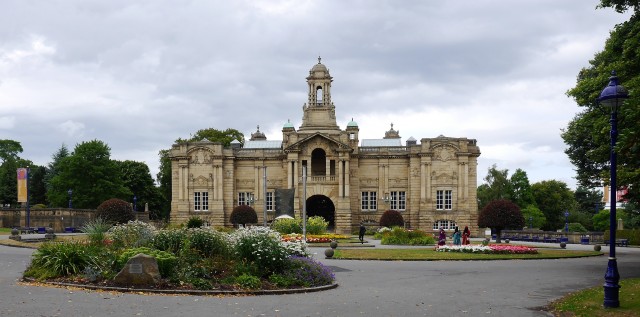
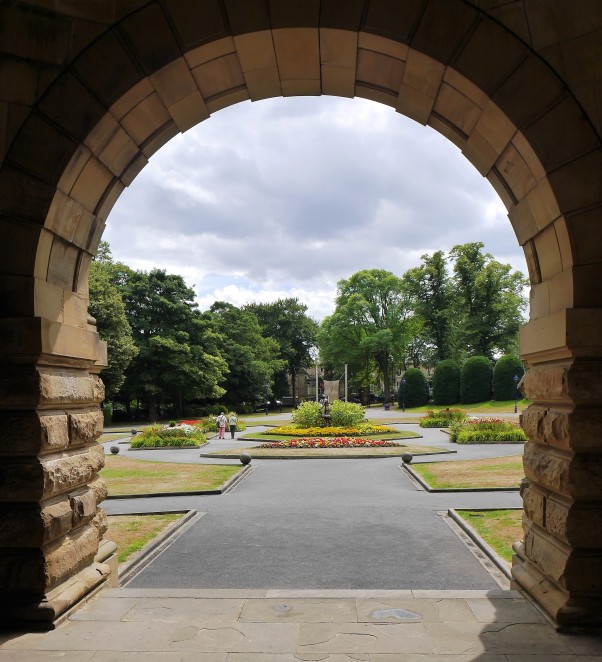




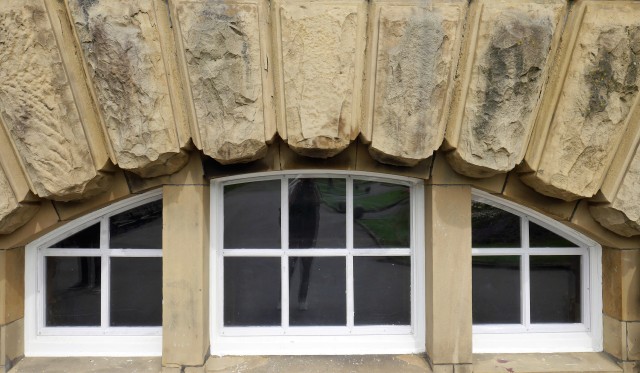
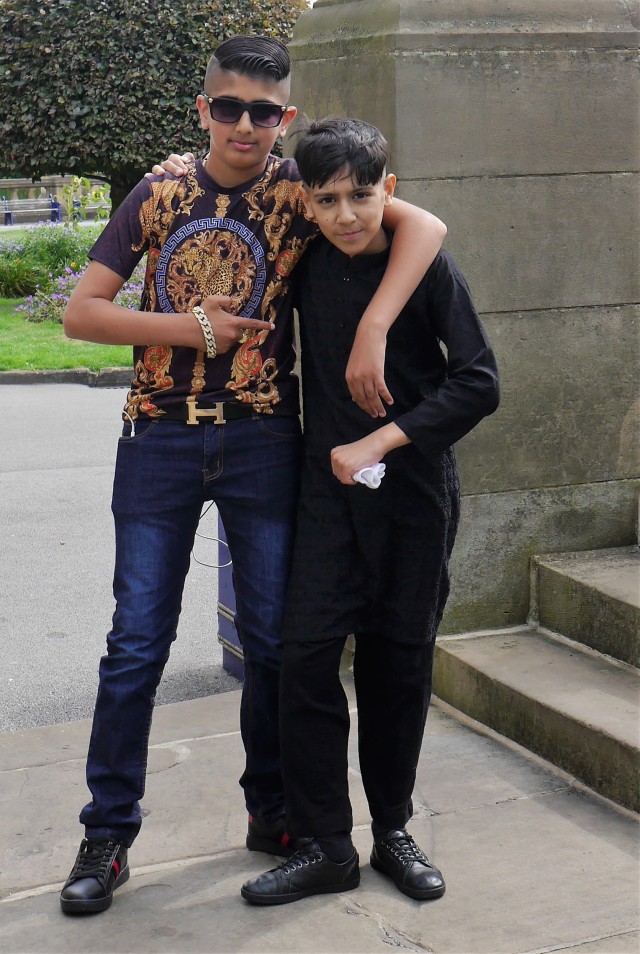



The genie was, unfortunately, never put all the way in the bottle to begin with, although it complained as if it had been. What do we do? Anything we can. If we’re on the train with the man talking about “filthy Pakis,” we say something, however hard it is. We do what you’ve done–write about it. Whenever we get the chance, and however uncomfortable it makes us, we refuse to let racists set the tone of the conversation. And next time someone complains about political correctness, we start throwing things, because I swear sometimes it’s the only sane response.
LikeLiked by 2 people
Thank goodness you replied – and in this vein. I had no idea how this might be received – if indeed anyone took the time to read it.
I love your suggestion about political correctness. A young friend was recently working in a care home for adults with learning difficulties and was shocked to hear one of his colleagues routinely calling their charges ‘mongs’. And it was a shock to me, thinking back not that many years, to when ‘Mongols’, ‘Spastics’ – and many perhaps worse names were routinely applied to people who didn’t fit our society’s definition of normal. I’d rather go to the PC extreme than the other, frankly. And, yes, if I had been on that train I would definitely have said something. I’m guessing there were no other adults around? I hope that’s how it was, anyway, or it would be an even worse episode. The same friend told a story of a taxi driver in respectable York – on the way to the university who asked what she was studying. It was women in Nazi Germany at the time. He said he wasn’t a racist… but thought Hitler was right about the Jews.
Sometimes I can’t believe my fellow humans.
LikeLiked by 1 person
Right: “I’m not a racist but…” It’s enough to make me want to scream.
I’d love to think you were right about no adults being around on that train, but if I was going to bet on it, I’d bet there were but they didn’t want to call attention to themselves, they were embarrassed, they were afraid, or they didn’t know what to say or how to say it. It’s hard to get into the middle of these things–especially for the English, I think, who can be pretty reticent in the best of situations. It needs to be done, but let’s acknowledge that it’s not easy.
LikeLike
Let’s not throw things. There are better ways to bring change.
LikeLiked by 1 person
I admit, it’s not the most useful impulse I have.
LikeLiked by 2 people
So say us all 🙂
LikeLiked by 2 people
Extremely interesting and to the point. I thought this was especially well said: “We discussed how Trump, Farage and co have effectively given such people permission to voice hatred of the other.”
And I do wish we knew how to put the geni back into the bottle! If you find out, let me know.
LikeLiked by 2 people
He’s a tricky blighter. But that won’t stop us trying!
LikeLiked by 1 person
What a powerful piece you’ve written here — especially your insight about the (caring, liberal, white, women) teachers who advise their students that they will have equal opportunity if only they play by the rules. And don’t even get me started about the so-called leaders who deliberately scapegoat and divide! We can only hope that boys like your friend’s son will learn from what they’re witnessing and vow to create a better world.
LikeLiked by 2 people
Thanks Heide, yes, that point she made was what really shocked me out of my world-news-weariness. Yes, I hope for the future when I see some of the young people around – sometimes we have to look behind the bad news which tends to hide the many good, caring and responsible youngsters.
LikeLiked by 2 people
I’m always a bit surprised to read/hear about people in areas that are not as diverse or used to other customs as it is here in TX. It’s common in any one afternoon to hear multiple languages, see various dress in the grocery stores and just about everywhere. We are really more alike than different. (If it matters, this is a minority majority city with white population small. Many Asian, mainland Chinese, various Islanders, Africans, Middle Eastern, Of course Pakistani as well as Central and South Americans, Researchers say this area is what the rest of the US will look like shortly.) It’s really a lot of fun to have such a rich varied city: the food, the music, the entertainment, and the philosophies.
Are really most of the instructors and teacher there mostly white women still? Even in the distant outlying suburbs that’s far from the norm here.
Really enjoyed your post and pictures – loved th arched windows with stonework. Such skill involved in the older architecture and buildings. How interesting how the museum had changed. Fossils are so interesting to kids – hope they are somewhere accessible for viewing. Museums are the coolest places for kids to explore.
LikeLiked by 1 person
Britain has many cities that are as you describe, mixed, vibrant, fun, multicultural and happy with it. They tend to be places that are relatively affluent and where there is adequate employment – and quality employment at that. But Bradford is not as mixed as the city you describe.
Bradford has a history that has set it up for problems. (Bear with me this is overly simplistic…) In the 19th and for half of the 20th century it was probably THE top woollen textile manufacturing city in the world. And rich. So many people were needed to operate the woollen mills and the other mills which supported them – engineering, chemical etc – in the mid-20th century that they were brought in from the empire, from the Asian subcontinent especially – in large numbers. Whereas those coming from Poland, Ukraine and Czechoslovakia after WWII were less visible, the Pakistanis and others were visibly different. And not welcome. They stuck together as a result. Then the industry declined. It is virtually non-existent today. But all those people are still there and unfortunately if you look at the stats about education (poor attainment) and the type of work available it is low skilled, low level stuff and unemployment is high in the immigrant heavy areas.
It is very sad to see so many empty mills standing useless and vandalised – and the city is visibly poor.
The friend who talked about white women teachers probably had specific children in mind, those from more affluent or aspirational Asian families who sent their children to schools in ‘white’ areas or paid for private schooling. And sadly, one of the issues which still pertains in many places like Bradford is women remaining indoors and often poorly educated.
Add to all this that transport links to and from the city are appalling -it is the end or a railway line for example – perfect post-industrial storm. It is in the north of England also, which does tend to be neglected by central government. Not a full explanation and I am no expert but… Not an easy case to solve.
The fossils have gone to a castle!
LikeLiked by 1 person
A castle! Somehow ironic?
I know many places there are as multilingual as we are here. There are always pocket
That area sounds like the “Rust Belt” areas here which were once vibrant manufacturing areas, but became outdated and people were not looking down the road so new skills were not learned for new industries. People unlike previous eras didn’t move to areas with jobs, but sat and declined.
Certain immigrants over the last decade here have tended to buy/ rent in areas and stick together – really not a good way to become part of the city. Even in the schools with a good mix of students, some groups isolate themselves in the lunch room and such. It’s hard on the kids as they get older – they really become “Americanized” and are stuck between what they want to be and the pressure from their parents to stay with their own people and heritage. More so now than after WWII. Kids are the hope.
Two funny things I thought: Asians and many Hispanics here were often grouped with “white” – even in school data and census for a long time (but then there were only 2 categories: White and nonwhite)
The second as I was watch a Kroger grocery store commercial I’ve seen multiple times before, I realized the young man in it was Pakistani – I never noticed before, but it’s obvious. Sooner or later it’ll all work out if people calm down…eventually dinosaurs and old ideas die off.
Appreciate the additional information!
LikeLiked by 1 person
The castle is still in the same area and not as inaccessible as it sounds! It’s just not in an inner city park 😦
LikeLike
Even though I would be (being of WASP heritage) part of the minority what you describe is really as it should be, and hopefully each person one day equal in standing and opportunity.
LikeLiked by 1 person
It seems as though too many people feel it’s their right to have something to say… However, I remembering growing up we were oft reminded “If you can’t say something nice, don’t say anything at all.” The risk of faux pas in being (publicly) uncouth or unkind was far greater than the need to blurt out a thoughtless opinion, long remembered after things well considered and spoken were forgotten.
LikeLiked by 1 person